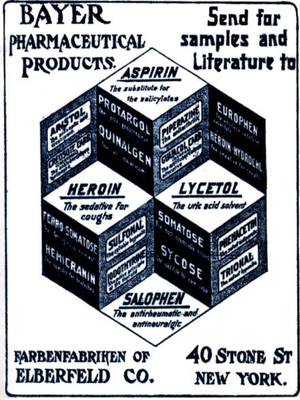This week in science history - The discovery of Aspirin
Interview with
This week in science history saw, in 1897, Felix Hoffman first synthesise a stable form of acetylsalicylic acid for medical use, better known as aspirin.
 Aspirin, or acetylsalicylic acid, is a 'salicylate' drug that as well as its best known effect as an 'analgesic' to reduce aches and pains can also be used as an 'antipyretic' to control fever, and as an anti-inflammatory to reduce inflammation. It also has the effect of making the blood less likely to clot, known as anti-coagulation. It was the first 'non steroidal anti inflammatory drug' to be discovered (another example being ibuprofen), and it had the huge benefits of reducing pain without impairing consciousness and was not addictive unlike opiate painkillers such as laudanum.
Aspirin, or acetylsalicylic acid, is a 'salicylate' drug that as well as its best known effect as an 'analgesic' to reduce aches and pains can also be used as an 'antipyretic' to control fever, and as an anti-inflammatory to reduce inflammation. It also has the effect of making the blood less likely to clot, known as anti-coagulation. It was the first 'non steroidal anti inflammatory drug' to be discovered (another example being ibuprofen), and it had the huge benefits of reducing pain without impairing consciousness and was not addictive unlike opiate painkillers such as laudanum.
Salicylate based medicines derived from plants like meadowsweet and willow trees had already been in use for over 3 and a half thousand years by the 19th century, to reduce aches and pains and fever. In fact the name 'salicylic acid' comes from the Latin name for the willow tree, Salix. In the 1820s and 30s, chemists in Italy and Germany managed to purify the active chemical found in these plants - salicylic acid. The medicinal use of this grew in the mid 1800s, but it did have several drawbacks, including the fact that it caused stomach pain, ulcers and even stomach bleeding.
Around this time, an industry began to grow in Germany to investigate medicines that could be derived from cloth dyes made from coal tar. Surprising as it might sound given the starting point of coal tar, a lot of compounds were found that could be used to reduce fever and pain. A German dye firm called Friedrich Bayer and Company began to expand to investigate medicines further, seeing that there was money to be made. It was this company that Hoffman joined as a young man in 1894, to work with two chemists called Eichengrün and Dreser.
 In 1897, Eichengrün instructed Hoffman to find an alternative form of salicylic acid that would be less irritating to the stomach, but would still produce anti fever and pain effects. In his lab book entry for the 10th of October 1897, Hoffman declared that he had synthesised a pure form of acetylsalicylic acid by refluxing salicylic acid with acetyl anhydride. This ended up producing a much purer and more stable form of acetylsalicylic acid than had been produced before using other techniques. Clinical trials suggested that it was just as effective as salicylic acid without many of the unpleasant side effects. However, it was not until 1899 that the name Aspirin was decided on and the Bayer began producing it for use as a prescription drug. It was not available over the counter until after the turn of the century.
In 1897, Eichengrün instructed Hoffman to find an alternative form of salicylic acid that would be less irritating to the stomach, but would still produce anti fever and pain effects. In his lab book entry for the 10th of October 1897, Hoffman declared that he had synthesised a pure form of acetylsalicylic acid by refluxing salicylic acid with acetyl anhydride. This ended up producing a much purer and more stable form of acetylsalicylic acid than had been produced before using other techniques. Clinical trials suggested that it was just as effective as salicylic acid without many of the unpleasant side effects. However, it was not until 1899 that the name Aspirin was decided on and the Bayer began producing it for use as a prescription drug. It was not available over the counter until after the turn of the century.
The popularity of Aspirin grew and grew in the first few decades of the 20th century, especially after its widespread and successful use in controlling pain and fever in victims of the 1918 flu pandemic. However, its use by the public around the world was reduced on the introduction of paracetamol in 1956 and ibuprofen in 1969. Alarming evidence that it might cause Reye's syndrome - a potentially fatal disease involving organ failure - in children after being used to treat them for chicken pox also decreased its popularity. It is now advised not to be given to children under 16. Its anticoagulate effects were shown in the 1970s, and after this aspirin came back into widespread use and is still in use today as a preventative measure against strokes and heart attacks by reducing the likelihood of a blood clot.
With a discovery of such magnitude and with money and fame to be had, there is unsurprisingly a lot of controversy surrounding the discovery of aspirin. Eichengrün released a paper in 1949, three years after Hoffman's death, arguing that he should be credited with the discovery of aspirin and that Hoffman had just been following his instructions. This account of events was not supported until 1999, when a researcher at Strathclyde University examined the case and came out in support of Eichengrün. Bayer, the pharmaceutical company that Hoffman and Eichengrün had been working for at the time dismissed the findings and stood behind Hoffman. As of 2004, the controversy is still unresolved.
The events that led to the production and widespread use of aspirin are an important chapter in the history of medicine. It was the first modern painkilling drug that could be used without affecting a person's day to day activities and has brought relief to millions of people over the years. Although less in use as a painkiller now, it still plays a vital role in medicine.









Comments
Add a comment